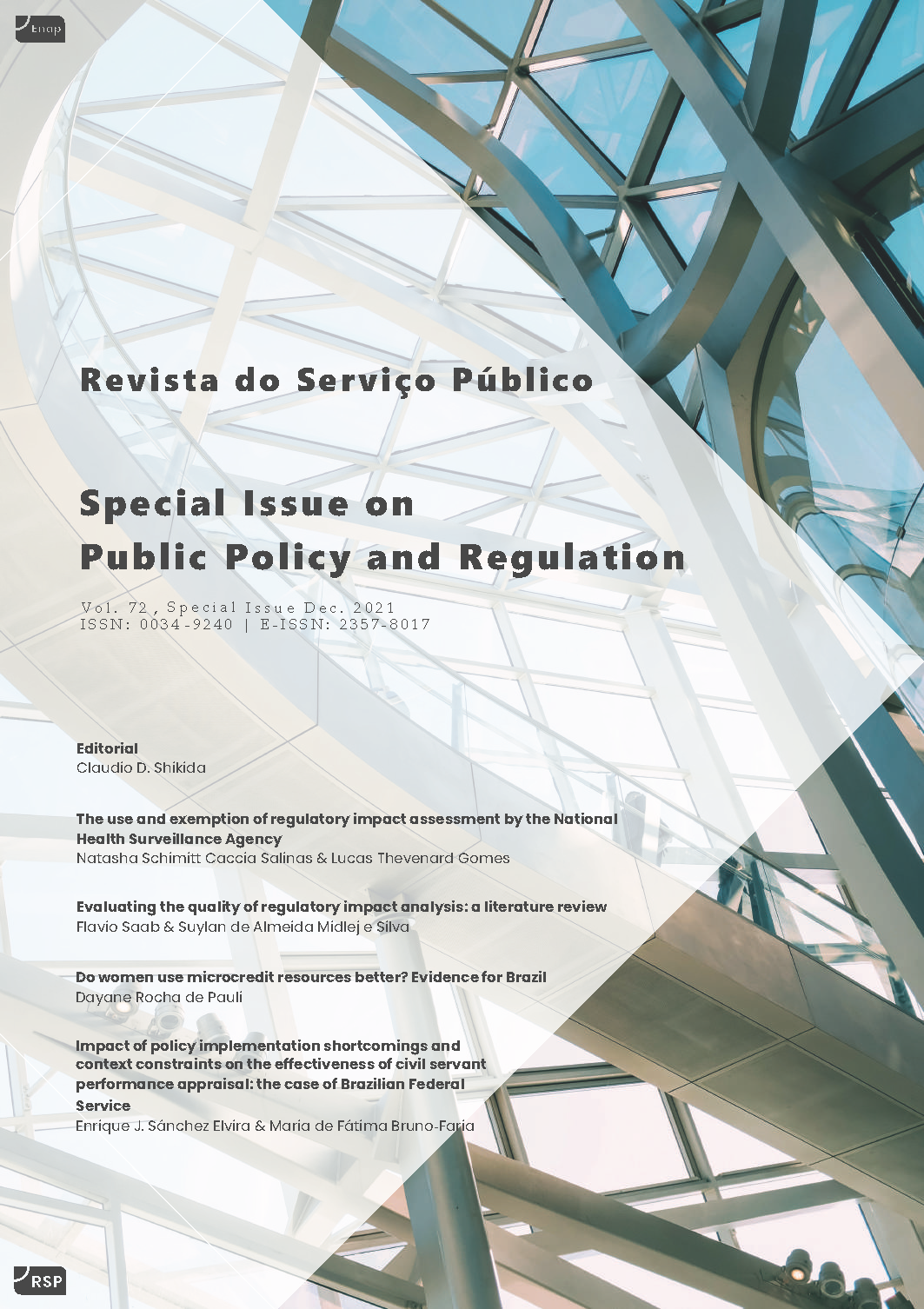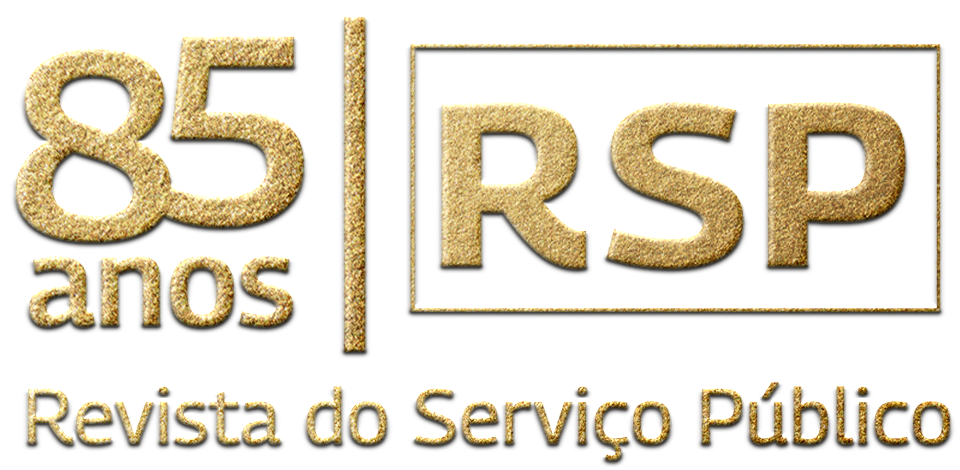The use and exemption of Regulatory Impact Assessment by the National Health Surveillance Agency
Keywords:
regulatory reform, regulatory impact assessment, National Health Surveillance Agency, Anvisa, empirical researchAbstract
Regulatory impact assessment—RIA—is increasingly important for Brazilian Administrative Law, especially after the ‘Economic Freedom Act’ (Lei de Liberdade Econômica) extended its scope of implementation to all public bodies and federal administration entities. This work analyses the evolution of RIA under the purview of the National Health Surveillance Agency (Anvisa), a federal agency that stands out for being at the forefront of RIA implementation in Brazil. To this end, data published on the legislation section of the agency’s website about the use of RIA to substantiate Directors' Collegiate Regulations (Resoluções de Diretoria Colegiada) and Normative Instructions (Instruções Normativas) between 2011 and 2020 were collected. The total number and proportion of cases in which the Directors' Collegiate approved the realization or dispensation of RIA, based on relevant normative acts collected in this period, are presented. It was found that, in most cases, there were exemptions from RIA, and this proportion was not reduced over time. Furthermore, in cases of exemption, it was observed that the urgency/severity of the process was used as justification in a high proportion of cases. Finally, it was also observed that the use of RIA and exemption justifications vary according to the subject of the regulatory norm in question. The results of this study advance the existing knowledge about the implementation of RIA in Brazil and suggest new avenues of qualitative research on the factors that influenced the use and exemption of RIA by Anvisa.
Downloads
References
Alves, F. N. R., & Peci, A. (2011). Análise de Impacto Regulatório: Uma nova ferramenta para a melhoria da regulação na Anvisa. Revista de Saúde Pública, 45(4), 802–805. https://doi.org/10.1590/S0034-89102011000400023
Atienza, M. (1997). Contribución a uma teoria de la legislación. Civitas.Baldwin, R. (2010). Better Regulation: The Search and the Struggle. In R. Baldwin, M. Cave, & M. Lodge, The Oxford Handbook of Regulation. Oxford Handbooks Online.
Bana e Costa, C. A., de Corte, J.-M., & Vansnick, J.-C. (2011). MACBETH (Measuring Attractiveness by a Categorical Based Evaluation Technique). In J. J. Cochran, L. A. Cox, P. Keskinocak, J. P. Kharoufeh, & J. C. Smith, Wiley Encyclopedia of Operations Research and Management Science. John Wiley & Sons, Inc. https://doi.org/10.1002/9780470400531.eorms0970
Casa Civil. (2018). Diretrizes gerais e guia orientativo para elaboração de análise de impacto regulatório—AIR. Governo Federal. https://www.gov.br/casacivil/pt-br/centrais-de-conteudo/downloads/diretrizes-gerais-e-guia-orientativo_final_27-09-2018.pdf/@@download/file/diretrizes-gerais-e-guia-orientativo_final_27-09.pdf
Chevallier, J. (1992). A Racionalização da Produção Jurídica. Cadernos de Ciência da Legislação, 3, 9–23.
Coglianese, C., Kilmartin, H., & Mendelson, E. (2009). Transparency and Public Participation in the Rulemaking Process. Faculty Scholarship at Penn Law. https://scholarship.law.upenn.edu/faculty_scholarship/238
Costa, C. A. B. e, Vieira, A. C. L., Nóbrega, M., Quintino, A., Oliveira, M. D., & Costa, J. B. e. (2019). Collaborative Value Modelling in corporate contexts with MACBETH. Procedia Computer Science, 162, 786–794. https://doi.org/10.1016/j.procs.2019.12.051
Guerra, S., Salinas, N. S. C., & Gomes, L. T. (2020). As agências reguladoras em resposta à crise da COVID-19. Revista de Administração Pública, 54(4), 874–897. https://doi.org/10.1590/0034-761220200321
McCubbins, M. D., Noll, R. G., & Weingast, B. R. (1987). Administrative Procedures as Instruments of Political Control. Journal of Law, Economics, & Organization, 3(2), 243–277.
Medauar, O. (2008). A processualidade no direito administrativo (2a. ed. rev., atualizada e ampliada). Editora Revista dos Tribunais.
Meneguin, F. B., & Saab, F. (2020). Análise de Impacto Regulatório: Perspectivas a partir da Lei da Liberdade Econômica [Texto para Discussão no 271]. Núcleo de Estudos e Pesquisas/CONLEG/Senado.
Moe, T. M. (1989). The Politics of Bureaucratic Structure. In J. E. Chubb & P. E. Peterson (Orgs.), Can the government govern? (p. 267–329). Brookings Institution.
Morall, J. (1997). An Assessment of the US Regulatory Impact Analysis Programme. In OECD, Regulatory Impact Analysis: Best Practices in OECD Countries (p. 71–87). OECD Publishing.
National Health Surveillance Agency - ANVISA. (2008). Governo escolhe Anvisa para projeto piloto de regulação. Anvisa’s news page.
National Health Surveillance Agency - ANVISA. (2013). Análise de impacto regulatório: Anvisa é referência para agências. Anvisa’s news page.
OECD. (2008). Building an Institutional Framework for Regulatory Impact Analysis (RIA): Guidance for Policy Makers. OECD Publishing. https://www.oecd.org/gov/regulatory-policy/40984990.pdf
OECD. (2012). Recommendation of the Council on Regulatory Policy and Governance. OECD Publishing. https://doi.org/10.1787/9789264209022-en
OECD. (2015). Evidence-based policy making through Regulatory Impact Assessment. In OECD Regulatory Policy Outlook 2015 (p. 93–117). OECDPublishing. https://doi.org/10.1787/9789264238770-9-en
Proença, J. D., Costa, P. V. da, & Montagner, P. (2009). Desafios da regulação no Brasil. ENAP.
Radaelli, C., & De Francesco, F. (2010). Regulatory Impact Assessment. In R. Baldwin, M. Lodge, & M. Cave, The oxford handbook of regulation (Vol. 90, p. 563–564). Oxford University Press. http://doi.wiley.com/10.1111/j.1467-9299.2012.02049.x
Salinas, N. S. C., & Cerqueira, L. S. (2020). Análise de impacto regulatório na Lei Geral das Agências e na Lei de Liberdade Econômica: Fundamentos e tensões. Interesse Público, 22(124), 217–231.
Shapiro, S. A., & Schroeder, C. (2008). Beyond cost-benefit analysis: A pragmatic reorientation. Harvard Environmental Law Review, 32, 70.
Simon, H. A. (1997). Administrative behavior: A study of decision-making processes in administrative organization (4. ed). The Free Press.
Stodden, V. (2014). The reproducible research movement in statistics. Statistical Journal of the IAOS, 30, 91-93.
CITED LEGISLATION
National Health Surveillance Agency – Anvisa. Ordinance No. 354 of August 11, 2006. Available at: https://www.legisweb.com.br/legislacao/?id=197327. Last access on June 24, 2021.
National Health Surveillance Agency – Anvisa. Ordinance No. 422, of April 16, 2008. Available at: https://www.gov.br/anvisa/pt-br/centraisdeconteudo/publicacoes/regulamentacao/guia-para-o-programa-de-melhoria-do-processo-de-regulamentacao-da-anvisa.pdf. Last access on June 24, 2021.
National Health Surveillance Agency – Anvisa. Ordinance No. 1,381 of September 16, 2011. Available at: https://www.legisweb.com.br/legislacao/?id=235139. Last access on June 24, 2021.
National Health Surveillance Agency – Anvisa. Directors' Collegiate Resolution - RDC No. 255 of September 10, 2018. Available at: https://www.in.gov.br/materia/-/asset_publisher/Kujrw0TZC2Mb/content/id/54522298/do1-2018-12-11-resolucao-de-diretoria-colegiada-rdc-n-255-de-10-de-dezembro-de-2018-54521871. Last access on June 24, 2021.
National Health Surveillance Agency – Anvisa. Ordinance No. 1,741, of September 12, 2018. Available at: https://www.in.gov.br/materia/-/asset_publisher/Kujrw0TZC2Mb/content/id/55220083/do1-2018-12-14-portaria-n-1-741-de-12-de-dezembro-de-2018-55219864. Last access on June 24, 2021.
National Health Surveillance Agency – Anvisa. Service Orientation – SO No. 56, of September 18, 2018. Available at: http://antigo.anvisa.gov.br/documents/10181/5087466/OS_56_2018_BPR_COMP.pdf/1e57cdc2-9597-4677-bc62-4a99ceae9d8e. Last access on June 24, 2021.
National Health Surveillance Agency – Anvisa. Ordinance No. 162, of March 12, 2021. Available at: http://antigo.anvisa.gov.br/documents/10181/6242211/PRT_162_2021_.pdf/43a711e9-4d53-4496-afc5-6eb3d7287a07. Last access on June 24, 2021.
National Health Surveillance Agency – Anvisa. Service Orientation – SO No. 96, March 12, 2021. Available at: http://antigo.anvisa.gov.br/documents/10181/6242211/OS_96_2021.pdf/09b1a87b-5d8d-4703-8696-d5ca361b9c7a. Last access on June 24, 2021.
Brazil. Law No. 95, of February 26, 1998. Available at: http://www.planalto.gov.br/ccivil_03/leis/lcp/lcp95.htm. Last access on June 24, 2021.
Brazil. Decree No. 4,176, of March 28, 2002. Available at: http://www.planalto.gov.br/ccivil_03/decreto/2002/d4176.htm. Last access on June 24, 2021.
Brazil. Decree No. 6,062, of March 16, 2007. Available at: http://www.planalto.gov.br/ccivil_03/_ato2007-2010/2007/decreto/D6062.htm. Last access on June 24, 2021.
Brazil. Decree No. 9,191, of November 1st, 2017 Available at: http://www.planalto.gov.br/ccivil_03/_Ato2015-2018/2017/Decreto/D9191.htm#art59. Last access on June 24, 2021.
Brazil. Law No. 13,848, of June 25, 2019. Available at: http://www.planalto.gov.br/ccivil_03/_Ato2015-2018/2017/Decreto/D9191.htm#art59. Last access on June 24, 2021.
Brazil. Law No. 13,874, of September 20, 2019. Available at: http://www.planalto.gov.br/ccivil_03/_ato2019-2022/2019/lei/L13874.htm. Last access on June 24, 2021.
Brazil. Decree No. 10,441, of June 30, 2020. Available at: https://www.in.gov.br/en/web/dou/-/decreto-n-10.411-de-30-de-junho-de-2020-264424798. Last access on June 24, 2021.
Downloads
Published
How to Cite
Issue
Section
License
Copyright (c) 2021 Revista do Serviço Público

This work is licensed under a Creative Commons Attribution-NonCommercial-ShareAlike 4.0 International License.
- A RSP adota a licença Creative Commons (CC) do tipo Atribuição – Uso Não-Comercial (BY-NC).
- A licença permite que outros remixem, adaptem e criem obra licenciada, sendo proibido o uso com fins comerciais.
- As novas obras devem fazer referência ao autor nos créditos e não podem ser usadas com fins comerciais, porém não precisam ser licenciadas sob os mesmos termos dessa licença.
- Ao publicar o artigo na RSP, o autor cede e transfere para a ENAP os direitos autorais patrimoniais referentes ao artigo.
- O artigo publicado na RSP não poderá ser divulgado em outro meio sem a devida referência à publicação de origem.
- O autor que tiver o artigo publicado na RSP deverá assinar o Termo de Concessão de Direitos Autorais (em momento oportuno a editoria da Revista entrará em contato com o autor para assinatura do Termo).



